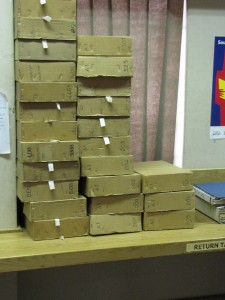On curiosities and letters
Please reference as: Liz Stanley (2017) ‘On Curiosities and Letters’ Whites Writing Whiteness www.whiteswritingwhiteness.ed.ac.uk/curiosities/on-curiosities/ and provide the paragraph number as appropriate when quoting.
 1. The original cabinets (or even rooms) of curiosities contained objects whose categorical boundaries were unknown, and so whose definitional and ontological being was not yet decided. They formed someone’s collection, but except for this were not ‘a set’ but instead diverse objects of different kinds which had been gathered under the heading of the wondrous and the curious. Representations of them look interesting, quite glamorous and, yes, curious. But they lack a certain something. This is dirt, dust, and yet more dirt; scruffiness in their appearance, and the dust of ages in their contents. They seem pristine in pictures, but in actuality…
1. The original cabinets (or even rooms) of curiosities contained objects whose categorical boundaries were unknown, and so whose definitional and ontological being was not yet decided. They formed someone’s collection, but except for this were not ‘a set’ but instead diverse objects of different kinds which had been gathered under the heading of the wondrous and the curious. Representations of them look interesting, quite glamorous and, yes, curious. But they lack a certain something. This is dirt, dust, and yet more dirt; scruffiness in their appearance, and the dust of ages in their contents. They seem pristine in pictures, but in actuality…
2. The archival equivalent of these things is not like the glamorous gleaming treasures of the most famous pictures of cabinets of curiosities. It is instead the towering piles of archive boxes, boxes which the workers in these places have eked out to them, usually one at a time. These have contents that can be oddly mixed and fascinate the delighted mind, but their dusty proofs of ageing also scour the hands, grit the eyes, dirty the clothes and hair.
3. Their contents also contain dust in the sense of detritus, the emptied  contents of pockets, files and desks as the slowly engulfing ashes of the Vesuvius of time have covered them over. How do these strange objects relate to each other? Who did they belong to and how did they use them? Who wrote what and why? How does any of it relate to the clear formalised certainties of published accounts of archival research? And, more than anything, just what ARE they?
contents of pockets, files and desks as the slowly engulfing ashes of the Vesuvius of time have covered them over. How do these strange objects relate to each other? Who did they belong to and how did they use them? Who wrote what and why? How does any of it relate to the clear formalised certainties of published accounts of archival research? And, more than anything, just what ARE they?
4. The WWW Curiosities brings together under this encompassing title all manner of letters. It includes the curious, the not yet known, the dubious, the frankly false. They enable questions to be asked – and some answers to them neither assumed nor prefigured, but explored. Who do letters from the past belong to? How to understand the ‘I’ of letter-writing? Under what circumstances does something stop being a letter and become something else? Are there other forms of writing that have all or most of the features of letters? And the questions continue.
5. The contents of the Curiosities are also to be enjoyed. The examples discussed range far and wide, from specific documents, to entire collections, to speculative thinking about letters and writing, to even more speculative thinking about the strange business of trying understanding the past and things that happened in it.
Last updated: 6 May 2021





